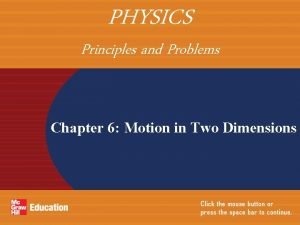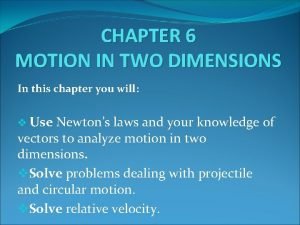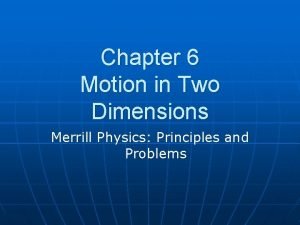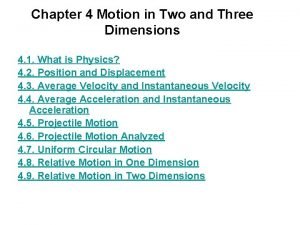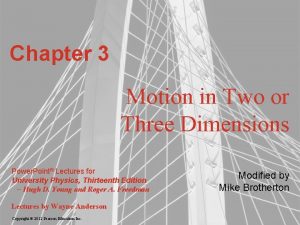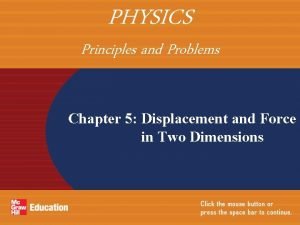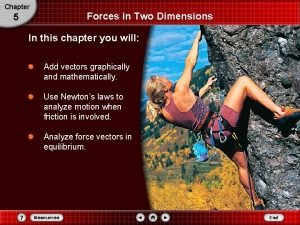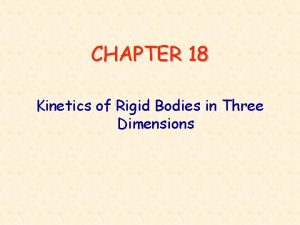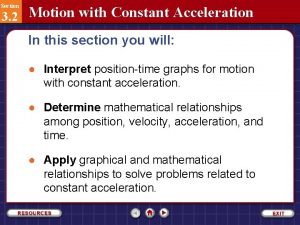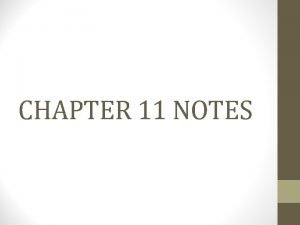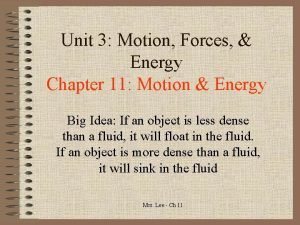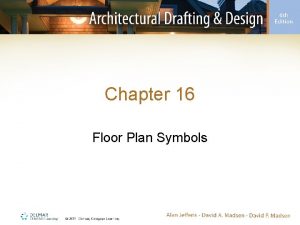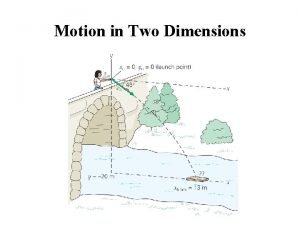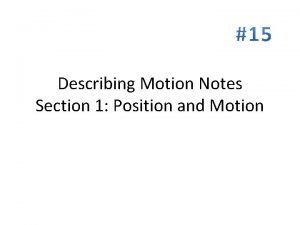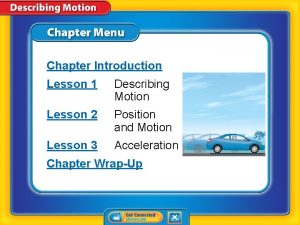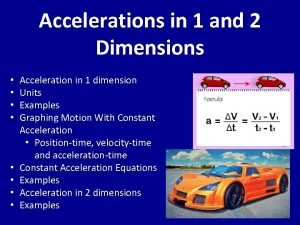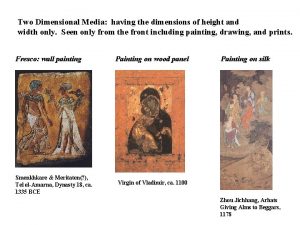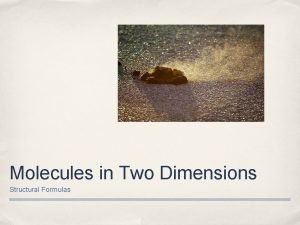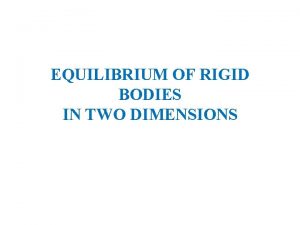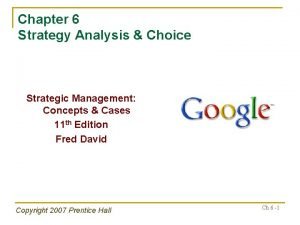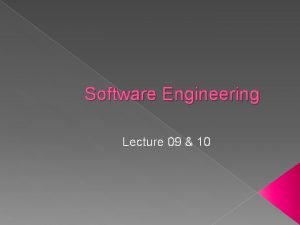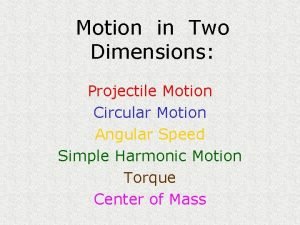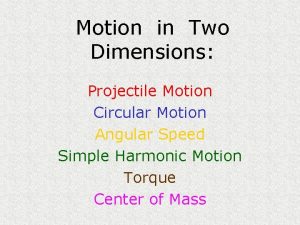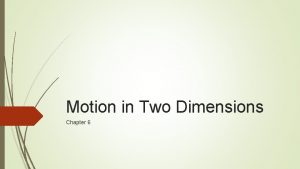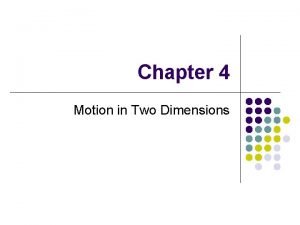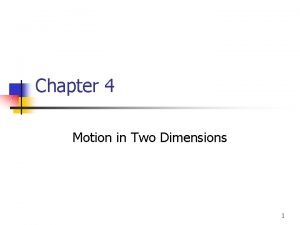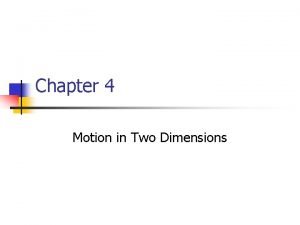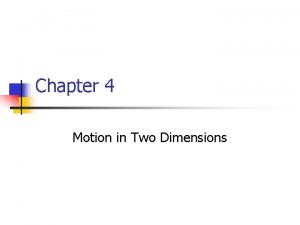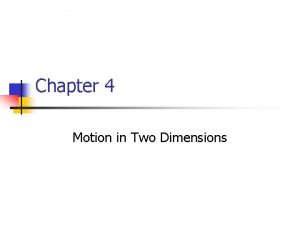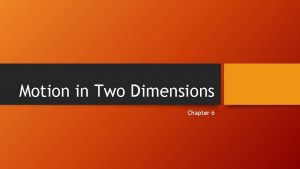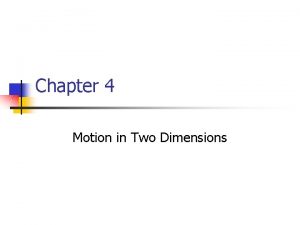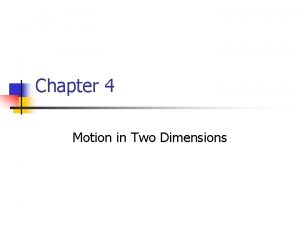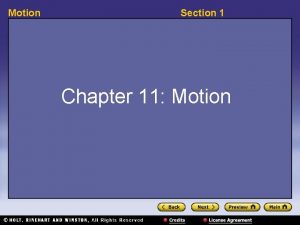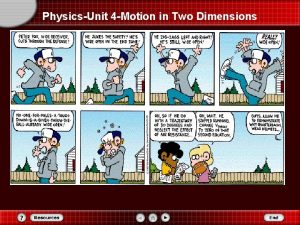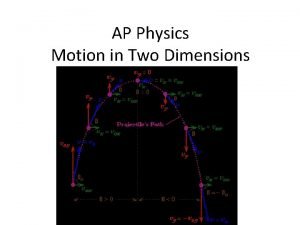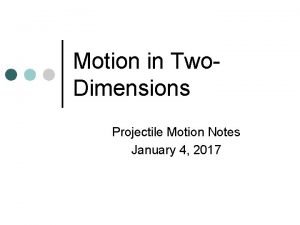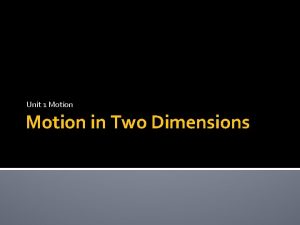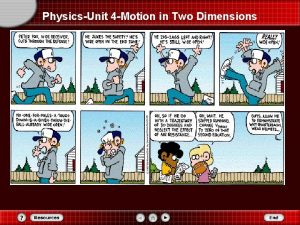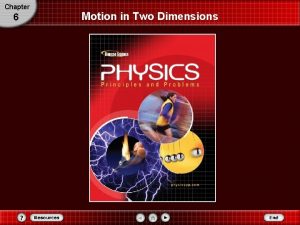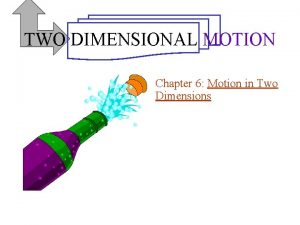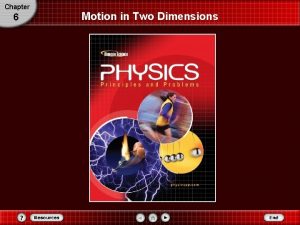Chapter 6 Motion in Two Dimensions Section 6




































- Slides: 36

Chapter 6 Motion in Two Dimensions

Section 6. 1 Projectile Motion n Essential Questions: ¨ How are the vertical and horizontal motions of a projectile related? ¨ What are the relationships between a projectile’s height, time in the air, initial velocity, and horizontal distance traveled?

Section 6. 1 Projectile Motion Projectile - motion of objects given initial velocity that move only under the force of gravity. n Trajectory - the path of the projectile n

Independence of Motion in Two Dimensions The horizontal and vertical velocities of a projectile are independent. n The shape of the trajectory depends on the viewpoint of the observer. n

Horizontally Launched Projectiles gravity will not affect horizontal motion n horizontal displacement (x) n horizontal velocity (vx) n time (t) ¨ vx = x t ¨ x = v xt n

Vertical Motion vertical displacement (y) n initial vertical velocity (vyi) n final vertical velocity (vyf) n constant acceleration (g) n time (t) ¨ y = vyit + ½ gt 2 ¨ vyf = vyi + gt n

Objects Launched Horizontally n The initial vertical velocity (vyi) is zero!

Ex #1. A stone is thrown horizontally at a speed of 5. 0 m/s from the top of a cliff 78. 4 m high. Find time and how far the stone is from the base of the cliff. 5. 0 m/s vxi = 5. 0 m/s vyi = 0 y = -78. 4 m g = -9. 80 m/s 2 y = vyit + ½ g t 2 (-78. 4 m) = 0 + ½ (-9. 8 m/s 2) t 2 78. 4 m (- 78. 4 m) = (- 4. 9 m/s 2) t 2 16 s 2 = t 2 t = 4. 00 s x = v xt x = (5. 0 m/s)(4. 0 s) x = 20. m

Ex #2. You are preparing breakfast and slide a plate on the countertop. Unfortunately, you slide it too fast, and it flies off the end of the countertop. If the countertop is 1. 05 m above the floor and it leaves the top at 0. 74 m/s, how long does it take to fall, and how far from the end of the counter does it land? vxi = 0. 74 m/s vyi = 0 0. 74 m/s y = -1. 05 m g = -9. 80 m/s 2 y = vyit + ½ g t 2 y = 1. 05 m x=? m (-1. 05 m) = 0 + ½ (-9. 8 m/s 2) t 2 (-1. 05 m) = (-4. 9 m/s 2) t 2 t = 0. 463 s x = vxt x = (0. 74 m/s)(0. 46 s) x = 0. 34 m

Objects Launched at an Angle We will use vertical and horizontal components. n At the highest point of the trajectory, the vertical velocity is zero (the object must stop to change direction). n The horizontal distance from the beginning to the end is called range (R). n The total air time is called “hang time. ” n

n Objects Launched at an Angle vel o city vy = 0. 0 m/s Init ial viy θ vix range y = 0. 0 m

Ex #3. A player kicks a football from ground level with a velocity of 27. 0 m/s and at an angle of 30. 0 above the horizontal. Find “hang time”, range, and maximum height. x - component y - component vx = (27. 0) cos 30˚ vy = (27. 0) sin 30˚ vx = 23. 4 m/s vy = 13. 5 m/s “Hang Time” y = vyit + ½ g t 2 0 = (13. 5 m/s) t + ½ (- 9. 80 m/s 2) t 2 0 = [13. 5 m/s + - 4. 90 m/s 2 t] t -13. 5 m/s = -4. 9 m/s 2 t vy = 13. 5 m/s t = 2. 76 s vx = 23. 4 m/s y = 0. 0 m

Ex #3. Continued vy = 13. 5 m/s vx = 23. 4 m/s range Range (x) x = vxt x = (23. 4 m/s)(2. 76 s) x = 64. 584 m x = 64. 6 m y = 0. 0 m

Ex #3. Continued Maximum Height Use ½ of the “hang time. ” y = vyit + ½ g t 2 vy y = (13. 5 m/s)(1. 38 s) + ½ (-9. 8 m/s 2)(1. 38 s)2 y = 18. 6 m - 9. 33 m = 13. 5 m/s y = 9. 3 m ymax vx = 23. 4 m/s y = 0. 0 m

Section 6. 1 Projectile Motion n Did We Answer Our Essential Questions? ¨ How are the vertical and horizontal motions of a projectile related? ¨ What are the relationships between a projectile’s height, time in the air, initial velocity, and horizontal distance traveled?

Section 6. 2 Circular Motion n Essential Questions: ¨ Why is an object moving in a circle at a constant speed accelerating? ¨ How does centripetal acceleration depend upon the object’s speed and the radius of the circle? ¨ What causes centripetal acceleration?

Describing Circular Motion n One might think that twirling an object in a circle does not accelerate due to the speed not changing. But it IS! Change in direction is a change in velocity!

Uniform Circular Motion n The movement of an object at a constant speed around a circle with a fixed radius.

Circular Motion n The radius and speed are constant, so the velocity is tangent to the curve.

Centripetal Acceleration (ac) n n n Acceleration is always toward the center of a circle. Also known as Radial Acceleration. ac or a. R Centripetal acceleration is directly proportional to the square of the speed and inversely proportional to the radius of the circle. a c= v 2 r

Period of a Revolution (T) The time needed to make a complete revolution. n Circumference of the circle is 2 π r which represents the distance around a circle. n v = 2πr T n

Derive Time! ac = v 2 and v = 2πr r T substitute v ac = (2πr/T)2/r ac = 4π2 r 2 / (r. T 2) ac = 4π2 r T 2

Centripetal Force (Fc) Force that is center seeking. n Using Newton’s 2 nd Law of Motion n ¨F = ma ¨ Fc = mac ¨F c= mac = mv 2 = m 4π2 r r T 2

Ex #4. A 0. 013 kg rubber stopper is attached to a 0. 93 m length of string. The stopper is swung in a horizontal circle, making one revolution in 1. 18 s. Find the speed, acceleration, and force. m = 0. 013 kg r = 0. 93 m T = 1. 18 s Speed m = 0. 013 kg r = 0. 93 m v = 2πr = 2(3. 14)(0. 93 m) T (1. 18 s) v = 4. 9 m/s Acceleration ac = v 2 = (4. 9 m/s)2 r (0. 93 m) ac = 26 m/s 2

Ex #4. Continued. m = 0. 013 kg r = 0. 93 m Force Fc = mac Fc = (0. 013 kg)(26 m/s 2) Fc = 0. 34 N

Ex #5. A 45 kg merry-go-round worker stands on the ride’s platform 6. 3 m from the center. If his speed as he goes around the circle is 4. 1 m/s, what is the force of friction necessary to keep him from falling off the platform? m = 45 kg 4. 1 m/s 6. 3 m r = 6. 3 m v = 4. 1 m/s Ff = F c Fc = mv 2 r Ff = (45 kg)(4. 1 m/s)2 (6. 3 m) Ff = 120 N

Centrifugal “Force” n Recall that centripetal acceleration is always directed toward the center of the circle, but we still feel the outward “force. ” This outward “force, ” called centrifugal force, is a fictitious force. What we are really feeling is the object that we are in also being directed inward, which makes us feel this outward “force. ”

Section 6. 2 Circular Motion n Did We Answer Our Essential Questions? ¨ Why is an object moving in a circle at a constant speed accelerating? ¨ How does centripetal acceleration depend upon the object’s speed and the radius of the circle? ¨ What causes centripetal acceleration?

Section 6. 3 Relative Velocity n Essential Questions: ¨ What is relative velocity? ¨ How do you find the velocities of an object in different reference frames?

Relative Motion in One Dimension n A coordinate system from which motion is viewed is a reference frame.

Different Reference Frames n Depending on the reference frame chosen, displacement, velocity, and acceleration may change.

Combining Velocity Vectors n When an object moves in a moving reference frame, you add the velocities if they are in the same direction. You subtract one velocity from the other if they are in opposite directions.

Ex #6: You are riding in a box car moving slowly at 15. 0 m/s. You walk to the front of the boxcar at 1. 2 m/s relative to the car. What is your speed relative to the ground? Both are going in the same direction, so we add the velocities. 15. 0 m/s + 1. 2 m/s 16. 2 m/s

Ex #7: Rafi is pulling a toy wagon through a neighborhood at a speed of 0. 75 m/s. A caterpillar in the wagon is crawling toward the rear of the wagon at a rate of 2. 0 cm/s. What is the caterpillar’s velocity relative to the ground? The caterpillar is moving opposite of the wagon, so we will subtract the two velocities. 0. 75 m/s – 0. 020 m/s 0. 73 m/s or 73 cm/s

Ex #8: Ana and Sandra are riding on a ferry boat traveling east at 4. 0 m/s. Sandra rolls a marble with a velocity of 0. 75 m/s north, straight across the deck of the boat to Ana. What is the velocity of the marble relative to the water? vb = 4. 0 m/s E vm = 0. 75 m/s N 0. 75 m/s 4. 0 m/s R 2 = v b 2 + v m 2 R 2 = (4. 0)2 + (0. 75)2 R = 4. 0697 = 4. 1 m/s θ = tan 1 -(y/x) = 10. 6197 = 11°

Section 6. 3 Relative Velocity n Did We Answer Our Essential Questions? ¨ What is relative velocity? ¨ How do you find the velocities of an object in different reference frames?
 Chapter 6 study guide motion in two dimensions
Chapter 6 study guide motion in two dimensions Rafi is pulling a toy wagon
Rafi is pulling a toy wagon Chapter 6 motion in two dimensions
Chapter 6 motion in two dimensions Chapter 6 motion in two dimensions
Chapter 6 motion in two dimensions Chapter 2 motion section 1 describing motion answer key
Chapter 2 motion section 1 describing motion answer key Describing and measuring motion
Describing and measuring motion Motion section 1 describing motion
Motion section 1 describing motion Motion in two and three dimensions
Motion in two and three dimensions Motion in two or three dimensions
Motion in two or three dimensions Vectors quick check
Vectors quick check Motion in two dimensions quick check
Motion in two dimensions quick check Concept 1 notes describing motion
Concept 1 notes describing motion Section 1 describing motion
Section 1 describing motion 5 displacement and force in two dimensions
5 displacement and force in two dimensions Chapter 5 forces in two dimensions worksheet answers
Chapter 5 forces in two dimensions worksheet answers Kinetic of rigid body
Kinetic of rigid body Chapter 2 motion section 3 acceleration answers
Chapter 2 motion section 3 acceleration answers Section 3 motion and forces worksheet answers
Section 3 motion and forces worksheet answers Describing and measuring motion
Describing and measuring motion Chapter 11 section 2 acceleration answer key
Chapter 11 section 2 acceleration answer key Chapter 11 section 3 motion and force answer key
Chapter 11 section 3 motion and force answer key Floor plan closet symbol
Floor plan closet symbol Acceleration in two dimensions
Acceleration in two dimensions Two dimensions of political ideologies
Two dimensions of political ideologies Formula of horizontal velocity
Formula of horizontal velocity Describing motion notes
Describing motion notes Position and motion
Position and motion Acceleration in two dimensions
Acceleration in two dimensions 2 dimensional media
2 dimensional media Molecules in two dimensions structural formulas
Molecules in two dimensions structural formulas Equilibrium of rigid bodies
Equilibrium of rigid bodies What are the two external dimensions of the space matrix?
What are the two external dimensions of the space matrix? Spiral model dimensions
Spiral model dimensions 4^x = 256
4^x = 256 Chapter 10 section 1 meiosis
Chapter 10 section 1 meiosis Motion and types of motion
Motion and types of motion Simple harmonic motion formula
Simple harmonic motion formula
